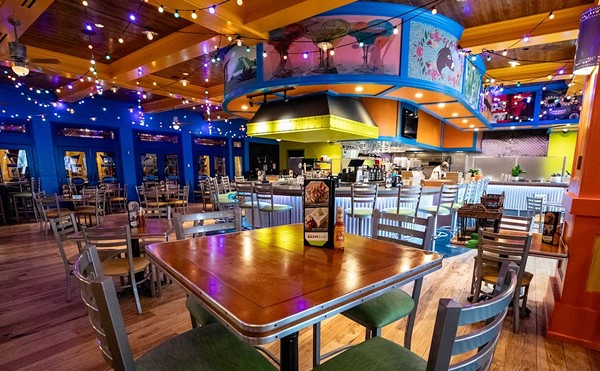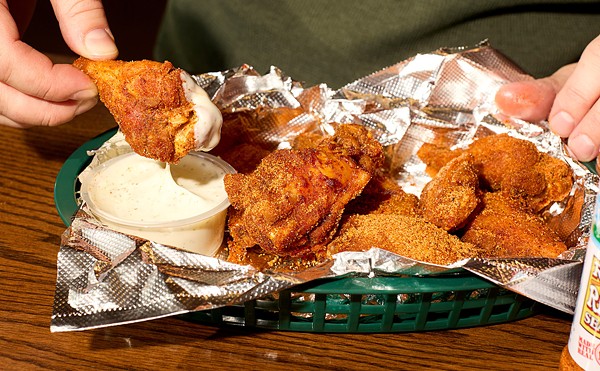If you're unfamiliar with the cuisine of New Mexico state — and, based on the dearth of New Mexican restaurants in St. Louis, you likely are — the best place to start is the stacked enchiladas at Adobe Reds. This might conjure an image of plump traditional enchiladas stacked Jenga-style into a precarious tower. In fact, the dish looks like a cross between lasagna and chilaquiles: four corn tortillas layered with your choice of smoked pork, shredded beef or grilled chicken and then topped with cheese and a red or green chile sauce (or "Christmas-style," with both).
The menu informs you that, in New Mexico, a fried egg is a mandatory addition to your stacked enchiladas. You might as well go all-in and get the fried egg.
I order my stacked enchiladas Christmas-style and with the fried egg. For the meat I choose pork, which is smoked over pecanwood, another hallmark of New Mexican cuisine. It's a colorful dish: The egg yolk quivering atop the enchiladas is a shade that's closer to orange than yellow, and both the red and green chile sauces, each poured over one half of the enchiladas, are vibrant.
Because this is a New Mexican dish, these are Hatch chiles. That's not a specific variety of chile; it refers to any one of the numerous chiles grown in and around Hatch, New Mexico. The red chile atop the stacked enchiladas is smoky and a touch hot, while the green chile is tangy and mild. Both sauces slice through the richness of the meat and egg and the ballast of the tortillas — indeed, they so dominate the flavor of the dish that you might forget what, exactly, you're eating.
Adobe Reds opened in May in the midtown building that Pappy's Smokehouse and Buffalo Brewing Co. also call home. Its space (formerly the restaurant the U) is one room, with the bar and open kitchen along one long wall, booths along the opposite wall and tables in between. The vibe is casual; the service, friendly, even chatty. The décor features a Southwestern palette of dusky reds and oranges. The soundtrack is classic rock played at a polite volume.
The menu isn't strictly New Mexican. Owner Tom Quinlan, who spent 35 years at National Restaurant Supply and other food-service firms, lived in Phoenix, Arizona, for two and a half years and styles this, his first restaurant, a "Southwestern Bar & Grill." In some cases, Adobe Reds merely gives conventional fare a Southwestern touch, like crab cakes spiked with green chile or salmon (served in a wrap) with an orange-chipotle rub. Unless there's a great salmon run in Taos of which I'm unaware.
Still, the most intriguing dishes are the New Mexican — loosely grouped together as the "house specialties" — such as pork adovada (a variation of the Mexican adobada). The menu describes this somewhat bluntly as slow-roasted pork "smothered" in red-chile sauce...except what you get is essentially a pile of slow-roasted pork drowned in red-chile sauce. This sauce struck me as having more bite but less character than the sauce with the enchiladas. If its role were to accent the pork, it might succeed. Too much of it sauces the pork, and the pork itself lacks distinct flavor.
Red-chile sauce also tops the smoked pork tamale. Here the ratio of sauce to tamale is just right, while the masa (which itself is spiked with red chile) helps smooth out the sauce's edge. The masa is on the dry side, however — the all-too-common fate of the tamale — and whatever method the kitchen is using to imbue the pork with a smoky flavor, it simply isn't working. As with the stacked enchiladas and the pork adovada, the pork in the tamale barely registers as an independent flavor.
Tacos are served three to an order, your choice of meat (pork, chicken, beef or chorizo) or seafood (fish, shrimp or crab cake) in a flour tortilla with cheese, pico de gallo and shredded cabbage. Mindful of my disappointments with the pork in other dishes, I ordered the fish tacos: The fish, mild on its own, has a decent peppery flavor vaguely reminiscent of Cajun blackened seasoning.
All of the house specialties are served with sides of rice and beans. The rice is rice, with a dash of red chile that's not enough to elevate it above, you know, rice. The beans have a strong hint of cinnamon. They aren't unpleasant, but they don't quite jibe with any of the main dishes. Serving everything with the same sides — especially when presenting a cuisine that will be new to many diners — seems like a missed opportunity.
The rice-beans combo also hints at the larger question at the heart of Adobe Reds: Does it want to distinguish itself as a unique restaurant? Or is it content to "distinguish" itself by adding a few unusual accents to a format we know too well both from St. Louis' many, many gringofied Mexican restaurants and also from our many, many conventional bar and grills?
Take the drink list: The margaritas are made with freshly squeezed lime juice rather than sour mix — a positive sign. Yet the other specialty drinks read like trends from five years ago. Pomegranate margarita, anyone? Someone cares enough about craft beer to offer Boulevard's terrific Tank 7 Farmhouse ale on draft, but the bottled-beer selection is the usual array of macrobrews — and there is exactly one red and one white wine available.
Sandwiches are conventional American-style creations (including wraps) with New Mexican accents. You can and should top the burger with green chiles. The burger itself is OK — charred medium to medium-well and simply seasoned, it isn't the juiciest specimen around, but the green chiles help.
The appetizers are uninspired: flatbreads and quesadillas. There is queso, the cheese blended with green chiles as well as pico de gallo and pinto beans. I blame that last ingredient for giving the dip a weird, funky aftertaste. Stick with the guacamole, zippy with lime. The complimentary salsa — featuring "fire-roasted" tomatoes and onions — is thin and bland.
Hidden among the soups and salads is a dish called Tucumcari chicken corn chowder. This isn't quite like any chowder I've had before; it's so thick as to barely qualify as a soup. It could use a dash of extra seasoning (salt, yes, and maybe a little spice), but the corn's sweetness and the green chile's tang work well together. Like the stacked enchiladas, it's a reminder that Adobe Reds can offer something new as well as New Mexican.






